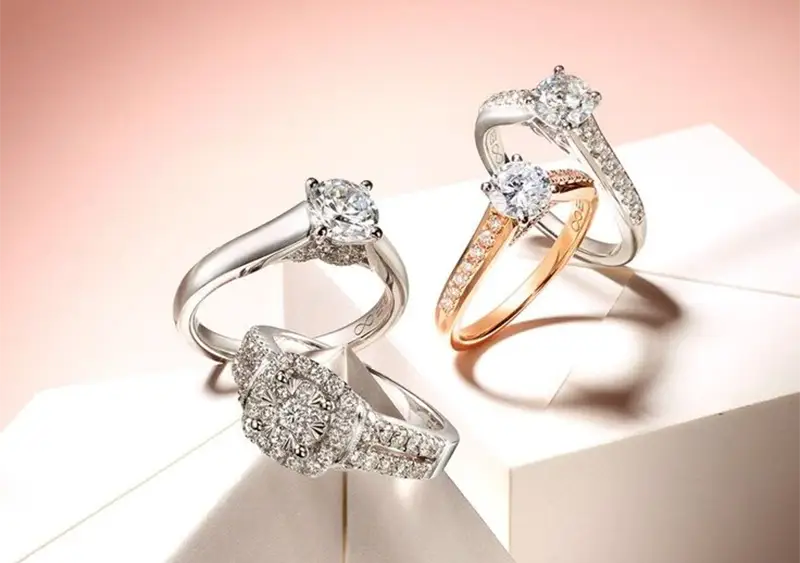Top 5 Benefits of 3D Jewelry Rendering for Online Retailers
"Visualize perfection before production."

5 MIN READ
May 31, 2025

Written By
Allwyn Ruban
Introduction
Let’s face it, selling jewelry online is tough. People can’t touch the piece. Can’t feel the weight. Can’t see how that sapphire catches light when it moves.
All they have is what you show them on-screen.
And that’s why visuals aren’t just part of the sales process they are the sales process. If your product photos are weak, blurry, or inconsistent? Scroll. If the angles aren’t right or the stone looks dull? Scroll.
But with 3D jewelry rendering, you're not just showing a product. You’re staging an experience that feels so lifelike, your customer leans in.
In this blog, we’ll break down the five biggest ways 3D rendering helps online retailers not just survive but sell smarter.
1. Photorealism That Builds Instant Trust
Online shoppers make decisions fast. We're talking milliseconds.
If the product image doesn't feel real, if the gemstone looks flat or the metal feels off they won’t waste time trying to imagine how it should look. They’ll just move on.
That’s where 3D jewelry rendering changes the game.
Done right, it doesn’t just look good it looks convincing. Every curve, shadow, sparkle, and reflection mimics how the piece would behave in natural light. It captures details that photography often misses:
- The subtle depth in an engraved band
- The sparkle shift in a princess-cut diamond
- The way gold warms up under soft shadows
Photorealistic renders build credibility. And in a world full of knockoffs and Photoshop disasters, credibility equals conversions.
Shoppers don’t need to second-guess. They trust what they see and that trust leads to faster clicks, fewer hesitations, and higher cart values.
2. Endless Variations Without Inventory Risk
In traditional retail, showcasing multiple versions of a product means one thing: stock.
Different metals? Different center stones? Different sizes? You’d need a physical sample for each.
But with 3D jewelry rendering, one model unlocks dozens of variations without ever touching your inventory.
Want to show the same ring in rose gold, yellow gold, and white gold? Done.
Need to swap a diamond for an emerald, ruby, or sapphire? Easy.
You can:
- Test-market new combinations before production
- Personalize previews for custom orders
- Offer on-the-fly variations for ecommerce filters
This flexibility means you’re not just saving money on prototyping.
You’re expanding your product catalog visually, without the cost and complexity of actual stock.
For online retailers, that’s freedom. Freedom to scale, experiment, and personalize while keeping costs low and offerings high.
3. Better Engagement Across Marketing Channels
Great visuals don't live in just one place.
Your customers are everywhere scrolling Instagram, watching product demos on YouTube, browsing your website, and comparing pins on Pinterest. What works in one format won’t always work in another.
That’s where 3D jewelry rendering becomes your content powerhouse.
You’re not locked into a single image. From one 3D model, you can create:
- Hero shots for landing pages
- Animated spins for social media
- Close-ups for ad creatives
- Lifestyle mockups for email campaigns
- Even AR-ready previews for virtual try-ons
The consistency is a bonus too. Your ring won’t look warm-toned on one page and cold-toned on another. Every visual stays true to your brand, across every touchpoint.
When customers see the same piece looking consistently polished and professional across platforms, engagement goes up. So does trust. And so do clicks.
4. Fewer Returns Thanks to Realistic Previews
Returns are the silent profit killer in online retail.
And in jewelry, it often comes down to one issue: "It didn’t look like the photo."
When product visuals are unclear or over-edited, customers make assumptions. They imagine a heavier ring. A brighter stone. A different scale. And when the real piece arrives? Disappointment.
3D jewelry rendering fixes that at the source.
By accurately simulating size, texture, material, and lighting, renders give buyers a true-to-life preview of what they’re getting. They can zoom in, view it from every angle, and understand exactly how it will look before they ever hit purchase.
The result? Fewer surprises.
Fewer complaints.
And a noticeable drop in return rates.
For online jewelry retailers, this isn’t just about reducing headaches. It’s about building long-term customer satisfaction and protecting your bottom line.
5. Faster Product Launches with Lower Costs
Launching a new jewelry line used to take weeks, sometimes months.
Sketch. Prototype. Photoshoot. Edits. Website updates. Multiply that by every product variation, and you’re looking at serious delays and expenses before a single piece hits the store.
3D jewelry rendering cuts that timeline dramatically.
Once your design is finalized, rendering allows you to:
- Skip physical prototyping for early marketing visuals
- Create campaigns and product pages before production begins
- Test-market ideas without burning inventory
You save time. You save budget. And more importantly you go to market faster.
This kind of agility is what gives smaller brands an edge. It also helps larger ones scale without bloating production costs. You’re not waiting on shipments or studio bookings. Your visuals are ready when your strategy is.
And in a fast-moving ecommerce world, that speed is gold.
ZealousXR’s Advantage: Rendering That Converts
At ZealousIndia, We don’t believe just in “pretty renders.”
We believe in visuals that stop the scroll, reduce the doubts, and push the customer to click. That’s the kind of rendering online retailers actually need.
They needed their pieces to speak clearly, confidently, and instantly before a customer ever touched them. If you’re wondering how to make the right choice for your brand, check out our guide on how to choose the right 3D jewelry rendering company.
Here’s what we bring to the table:
- Custom lighting setups that make gemstones glow, not glare
- Material accuracy so your white gold doesn’t look like stainless steel
- Quick variation renders to support marketing A/B tests, personalization, and fast launches
- And a workflow that’s built for collaboration, not confusion
We’re not here to just make your jewelry look nice. We’re here to make it convert.
Final Thoughts:
In online jewelry retail, the real challenge isn’t selling. It’s showing.
Customers won’t hold your product. They won’t try it on. All they get is what’s on-screen so that visuals better work overtime.
3D jewelry rendering isn’t just a tool. It’s a competitive edge. It lets you launch faster, sell smarter, and create buyer confidence from the very first glance.
And in a market this crowded, the difference between a scroll and a sale often comes down to a single, stunning image. If you’re ready to make that image count, you know where to start.
Let your product shine before it's real. Zealous Services helps you render jewelry that actually sells. Let’s create visuals your customers can’t ignore.
About the writer :
Allwyn Ruban heads business development and marketing at Zealous Services. He’s the go-to person for finding smart ... ways to grow their 3D services, from animation to modeling. With a knack for digital strategy, Allwyn is all about helping clients achieve their goals while expanding Zealous' reach in the industry. His friendly approach makes collaboration easy and effective.
Read MoreFrequently Asked Questions (FAQ)
Is 3D jewelry rendering suitable for high-end luxury pieces?
Absolutely. In fact, luxury brands often benefit the most because 3D rendering captures every fine detail, from rare stones to custom engravings.
Can I request different backgrounds or lifestyle scenes for each render?
Yes. We offer both clean product renders and custom scene creation for campaign visuals, banners, or social content.
Do I need to have CAD files to begin the rendering process?
Not necessarily. We can start from sketches, moodboards, or product references and help convert them into render-ready models.
How long does it take to get final renders?
Most projects are delivered within 3–7 business days depending on complexity and number of variations needed.
Can 3D renders be used for AR or virtual try-on experiences?
Yes. We can export formats suitable for augmented reality previews, virtual try-on tools, and interactive product viewers.
Table Of Contents
Introduction
Photorealism That Builds Instant Trust
Endless Variations Without Inventory Risk
Better Engagement Across Marketing Channels
Fewer Returns Thanks to Realistic Previews
Faster Product Launches with Lower Costs
ZealousXR’s Advantage: Rendering That Converts
Final Thoughts: